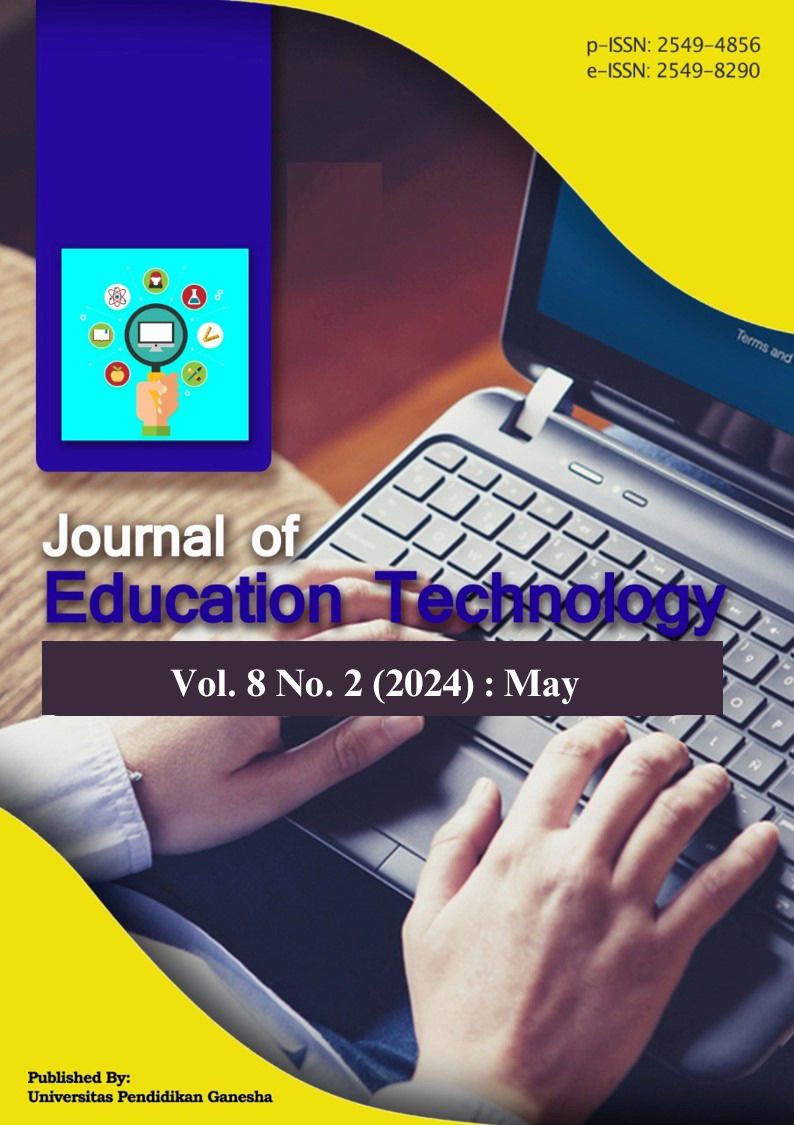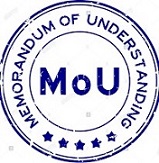Standardization in Digital Teaching and Learning in Higher Education: Indonesia Evidence
DOI:
https://doi.org/10.23887/jet.v8i2.70548Keywords:
Standardization, Digital, Teaching and Learning, Higher EducationAbstract
This research is motivated by the existence of new learning trends in the form of digital learning such as blended learning, online learning, MOOC, e-learning and various new learning trends that emerged in the era of the industrial revolution, but more effective digital learning standards have not yet been established. So this research aims to produce digital learning standards that are appropriate to the Indonesian context with diverse demographic and geographical conditions so that it is hoped that they can become guidelines for implementing digital learning in Indonesia, especially at the higher education level. This article specifically carries out the needs analysis process. This type of research is R & D using the 4D development method (define, design, development and dissemination) with research subjects of 50 students taken from 3 universities. The instruments used were questionnaires, observation and interview guidelines and were processed using a mixed method (a mix of qualitative and quantitative). Based on the results of the needs analysis, it is known that technological developments have been utilized by various levels of education to facilitate learning and overcome learning gaps evenly. There are also many case studies that prove that the presence of technology in learning makes learning much more optimal. However, there are no specific standards set to make the digital learning process more effective. Therefore, innovation is needed to produce digital learning standards.
References
Alawiyah, F. (2017). Standar Nasional Pendidikan Dasar dan Menengah. Aspirasi, 8. https://doi.org/10.18844/wjet.v13i3.5952.
Anih, E. (2016). Modernisasi Pembelajaran Di Perguruan Tinggi Berbasis Teknologi Informasi Dan Komunikas. Jurnal Pendidikan UNSIKA, 4(2), 185–196. https://doi.org/10.35706/judika.v4i2.391.
Beer, P., & Mulder, R. H. (2020). The Effects of Technological Developments on Work and Their Implications for Continuous Vocational Education and Training: A Systematic Review. In Frontiers in psychology (Vol. 11, p. 918). https://doi.org/10.3389/fpsyg.2020.00918.
Bosica, J., Pyper, J. S., & MacGregor, S. (2021). Incorporating problem-based learning in a secondary school mathematics preservice teacher education course. Teaching and Teacher Education, 102, 103335. https://doi.org/10.1016/j.tate.2021.103335.
Carayannis, E. G., Christodoulou, K., Christodoulou, P., Chatzichristofis, S. A., & Zinonos, Z. (2022). Known Unknowns in an Era of Technological and Viral Disruptions—Implications for Theory, Policy, and Practice. Journal of the Knowledge Economy, 13(1), 587–610. https://doi.org/10.1007/s13132-020-00719-0.
Cole, J., & Feng, J. (2015). Effective strategies for improving writing skills of elementary English language learners. Chinese American Educational Research and Development Association Annual Conference, 1–25. https://eric.ed.gov/?id=ED556123.
Fadhlan, A., Yuwanda, T., & Mulyani, S. R. (2022). Kepemimpinan Digital, Manajemen Inovasi dan Daya Saing di Era Revolusi Industri 4.0: Peran Mediasi dari Quality Management. Jurnal Bisnis & Kewirausahaan, 18(2), 2022. https://doi.org/10.31940/jbk.v18i2.138-148.
Fatimah, A. S., & Santiana, S. (2017). Teaching in 21St Century: Students-Teachers’ Perceptions of Technology Use in the Classroom. Script Journal: Journal of Linguistic and English Teaching, 2(2), 125. https://doi.org/10.24903/sj.v2i2.132.
Hasan, N., Soewarno, N., & Isnalita, N. I. D. N. (2019). Pengaruh Teknologi Informasi terhadap Proses Pembelajaran dan Prestasi Akademik Mahasiswa. Jurnal Kajian Akuntansi, 3(1), 26–37. https://doi.org/http://jurnal.ugj.ac.id/index.php/jka/article/view/2130.
Johnson, K. (2015). Behavioral Education in the 21st Century. Journal of Organizational Behavior Management, 35(1–2), 135–150. https://doi.org/10.1080/01608061.2015.1036152.
Karwati, E. (2014). Pengaruh Pembelajaran Elektronik (E-Learning) terhadap Mutu Belajar Mahasiswa. Jurnal Penelitian Komunikasi, 17(1), 41–54. https://doi.org/10.20422/jpk.v17i1.5.
Khairunnisa, A. (2022). Model Blended Learning dalam Meningkatkan Efektifitas Pembelajaran di Perguruan Tinggi. Blended Learning, 1(01), 9–22. https://journal.diginus.id/ITEJ/article/view/43.
Lazim, S. H. I. M., Arifin, K., Abas, A., Khairil, M., Ali, M. N., Lampe, I., Samad, M. A., Mahfudz, M., & Ciyo, M. B. (2022). A Systematic Literature Review on Leadership Practices for Safety in the Education Sector. Sustainability (Switzerland), 14(14), 1–16. https://doi.org/10.3390/su14148262.
Li, S., & Swanson, P. B. (2014). Engaging language learners through technology integration: Theory, applications, and outcomes. Engaging Language Learners through Technology Integration: Theory, Applications, and Outcomes, 1–368. https://doi.org/10.4018/978-1-4666-6174-5.
Malik, A. R., Pratiwi, Y., Andajani, K., Numertayasa, I. W., Suharti, S., Darwis, A., & Marzuki. (2023). Exploring Artificial Intelligence in Academic Essay: Higher Education Student’s Perspective. International Journal of Educational Research Open, 5, 100296. https://doi.org/https://doi.org/10.1016/j.ijedro.2023.100296
Martins, R. M., & Gresse Von Wangenheim, C. (2022). Findings on Teaching Machine Learning in High School: A Ten - Year Systematic Literature Review. Informatics in Education. https://doi.org/10.15388/infedu.2023.18.
Meyers, E. M., Erickson, I., & Small, R. V. (2013). Digital literacy and informal learning environments: An introduction. Learning, Media and Technology, 38(4), 355–367. https://doi.org/10.1080/17439884.2013.783597.
Miniawi, H. El, & Brenjekjy, A. (2015). Educational Technology, Potentials, Expectations and Challenges. Procedia - Social and Behavioral Sciences, 174, 1474–1480. https://doi.org/10.1016/j.sbspro.2015.01.777.
Nozari, H., Szmelter-jarosz, A., & Ghahremani-nahr, J. (2022). ( AIoT ) for the Smart Supply Chain ( Case Study : MDPI, 22(8), 1–18. https://doi.org/https://doi.org/10.3390/s22082931.
Núñez-Canal, M., de Obesso, M. de las M., & Pérez-Rivero, C. A. (2022). New challenges in higher education: A study of the digital competence of educators in Covid times. Technological Forecasting and Social Change, 174. https://doi.org/10.1016/j.techfore.2021.121270.
Octaviani, A., & Rizky, H. S. (2019). Pengaruh Persepsi Mahasiswa Dan Penerapan E-Learning Terhadap Peningkatan Kualitas Pendidikan Tinggi. ProBank, 4(1), 59–69. https://doi.org/10.36587/probank.v4i1.449.
Qian, Y., & Choi, I. (2022). Tracing the essence: ways to develop abstraction in computational thinking. Educational Technology Research and Development. https://doi.org/10.1007/s11423-022-10182-0.
Robandi, B., Kurniati, E., & Puspita Sari, R. (2019). Pedagogy In The Era Of Industrial Revolution 4.0. 239, 38–46. https://doi.org/10.2991/upiupsi-18.2019.7.
Rosita, N., Padang, U. N., Saun, S., & Mairi, S. (2019). Google Classroom for Hybrid Learning in Senior High School. Journal of Learning and Teaching in Digital Age, 5(1), 35–41. https://dergipark.org.tr/en/pub/joltida/issue/55477/760132.
Sujiwo, D. A. C., & A’yun, Q. (2020). Pengaruh Pemanfaatan E-learning Terhadap Motivasi Belajar Mahasiswa. JUSTINDO (Jurnal Sistem Dan Teknologi Informasi Indonesia), 5(2), 53–59. https://doi.org/10.32528/justindo.v5i2.3469.
Suwastika, I. W. K. (2018). Pengaruh e-learning sebagai salah satu media pembelajaran berbasis teknologi informasi terhadap motivasi belajar mahasiswa. Jurnal Sistem Dan Informatika (JSI), 13(1), 1–5. http://jsi.stikom-bali.ac.id/index.php/jsi/article/view/185.
Tegeh, I. M., Santyasa, I. W., Agustini, K., Santyadiputra, G. S., & Juniantari, M. (2022). Group Investigation Flipped Learning in Achieving of Students’ Critical and Creative Thinking Viewed from Their Cognitive Engagement in Learning Physics. Journal of Education Technology, 6(2), 350–362. https://ejournal.undiksha.ac.id/index.php/JET.
Tsang, Y. P., Wu, C.-H., Lam, H. Y., Choy, K. L., & Ho, G. T. S. (2021). Integrating Internet of Things and multi-temperature delivery planning for perishable food E-commerce logistics: a model and application. International Journal of Production Research, 59(5), 1534–1556. https://doi.org/10.1080/00207543.2020.1841315.
Varenina, L., Vecherinina, E., Shchedrina, E., Valiev, I., & Islamov, A. (2021). Developing critical thinking skills in a digital educational environment. Thinking Skills and Creativity, 41(July), 100906. https://doi.org/10.1016/j.tsc.2021.100906.
Williams, M. K., Foulger, T. S., & Wetzel, K. (2009). Preparing Preservice Teachers for 21st Century Classrooms: Transforming Attitudes and Behaviors About Innovative Technology. Journal of Technology and Teacher Education, 17(3), 393–418. https://www.learntechlib.org/primary/p/28216/.
Downloads
Published
How to Cite
Issue
Section
License
Copyright (c) 2024 Andi Kristanto, Siti Aisyah, Farida Febrianti, Utari Dewi, Pujiriyanto, Abna Hidayati, UL Budi, Lamijan Hadi Susarno

This work is licensed under a Creative Commons Attribution-ShareAlike 4.0 International License.
Authors who publish with the Journal of Education Technology agree to the following terms:
- Authors retain copyright and grant the journal the right of first publication with the work simultaneously licensed under a Creative Commons Attribution License (CC BY-SA 4.0) that allows others to share the work with an acknowledgment of the work's authorship and initial publication in this journal.
- Authors are able to enter into separate, additional contractual arrangements for the non-exclusive distribution of the journal's published version of the work (e.g., post it to an institutional repository or publish it in a book), with an acknowledgment of its initial publication in this journal.
- Authors are permitted and encouraged to post their work online (e.g., in institutional repositories or on their website) prior to and during the submission process, as it can lead to productive exchanges, as well as earlier and greater citation of published work. (See The Effect of Open Access)
















